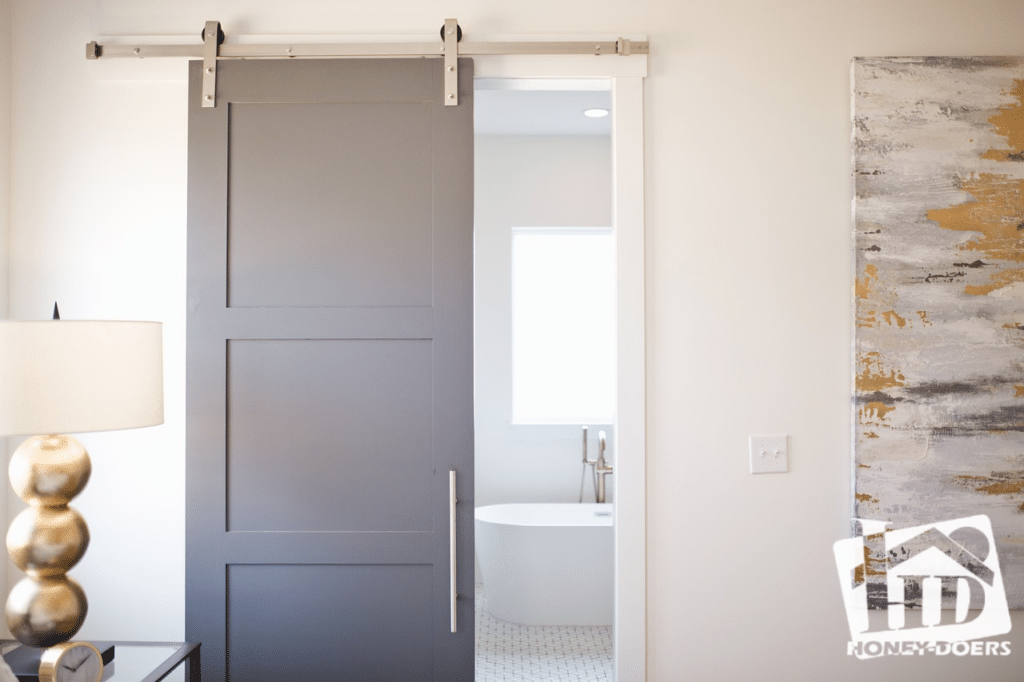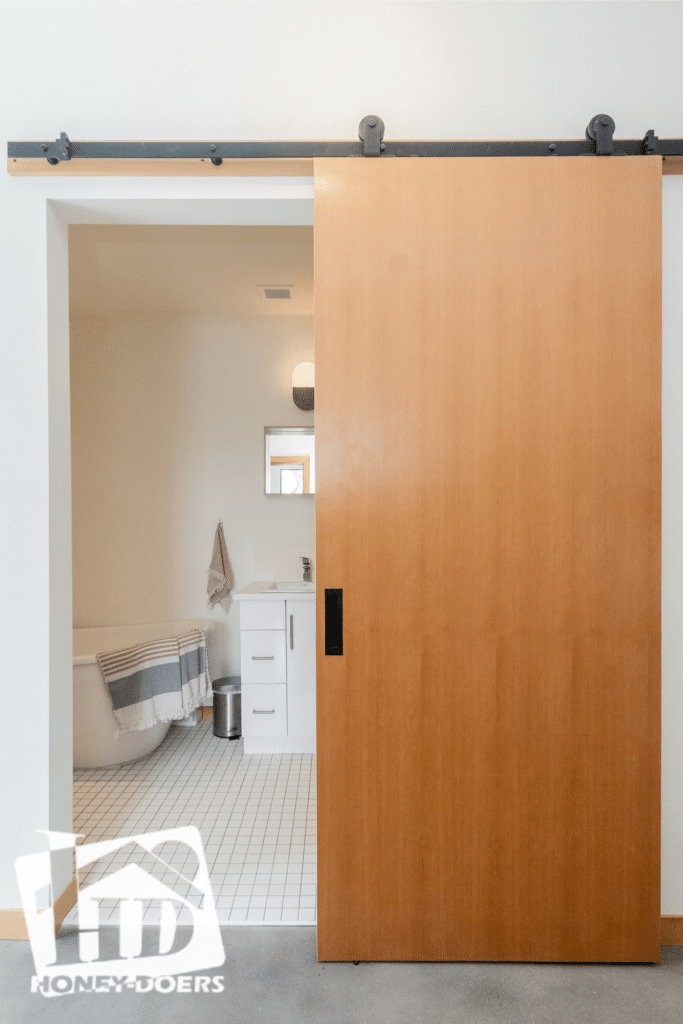Once quintessential elements of rustic barns, sliding barn doors have seamlessly transitioned into the realm of interior design, bringing with them a blend of functionality and aesthetic appeal. Their ability to save space, paired with the charm they add to any room, makes them an increasingly popular choice among homeowners looking to infuse their spaces with a touch of rustic elegance. This guide will explore the versatility of sliding barn doors, from how to hang them and lock them for privacy to their cost implications and cultural significance, offering everything you need to know about incorporating this timeless feature into your home.
Understanding Sliding Barn Doors
Sliding barn doors stand out from standard doors primarily due to their operating mechanism and aesthetic impact. Unlike traditional swinging doors, sliding barn doors glide along a track mounted above the doorway, offering a space-saving solution that adds character to any interior design. This unique functionality makes them ideal for areas where space is at a premium, such as small homes, apartments, or in rooms where maximizing floor space is crucial, like bathrooms, closets, and home offices.
Their adaptability to various design styles, from rustic to modern minimalist, allows sliding barn doors to complement almost any interior decor. The door itself becomes a focal point, often serving as a statement piece that elevates the overall design aesthetic of a room. Beyond their visual appeal, sliding barn doors offer practical benefits, providing an easy way to divide open spaces or conceal storage areas without the need for construction or permanent alterations to room layouts.
In Popular Culture
Sliding barn doors have not only made a significant impact on interior design trends but have also found their place in popular culture and iconic buildings, showcasing their versatility and timeless appeal.
- In the Movies: Sliding barn doors have been a backdrop in numerous films, adding a rustic charm to scenes. For instance, they’ve been prominently featured in country-themed romances or as elements in cozy cabin settings, contributing to the ambiance and setting the tone for intimate conversations or dramatic entrances.
- Notable Buildings: Architecturally, sliding barn doors have been ingeniously incorporated into both residential and commercial spaces. The rustic doors of the Barn House in California by Walker Workshop blend seamlessly with the modern aesthetic, providing a striking contrast. Similarly, the Magnolia Market at the Silos, renovated by Chip and Joanna Gaines, uses sliding barn doors to create a welcoming and versatile retail space that encapsulates the brand’s farmhouse chic style.
- Unique Architectural Projects: Architects and designers have been pushing the boundaries of how sliding barn doors can be used. From dividing large open-plan offices to creating flexible living spaces in tiny homes, these doors have been customized to fit an array of design needs. In some high-end homes, glass-paneled sliding barn doors are used to merge indoor and outdoor living spaces, offering a sleek, modern take on the traditional barn door design.
These examples highlight how sliding barn doors have transcended their humble beginnings to become emblematic of both a return to simplicity and an appreciation for innovative design. Whether in the movies, iconic buildings, or unique homes, sliding barn doors continue to charm and inspire.
As sliding barn doors continue to gain popularity in home design, understanding their benefits and suitability for your space is the first step toward incorporating this stylish and functional element into your home.
Sourcing Sliding Barn Doors
Finding the perfect sliding barn door for your home involves a journey through antique stores, specialty shops, and modern manufacturers. Authentic or vintage barn doors can be sourced from salvage yards and antique shops, where the hunt can uncover truly unique pieces steeped in history. These older doors often feature craftsmanship and materials that add an irreplaceable character to your space. For those seeking custom options, many manufacturers now offer sliding barn doors that can be tailored to your specific design preferences and size requirements. When selecting a sliding barn door, consider the door’s weight, material, and the style of your room to ensure it complements your home’s aesthetic. Additionally, it’s crucial to inspect vintage doors for durability and the potential need for refurbishment to make them suitable for indoor use. With a little patience and a keen eye for detail, you can find a sliding barn door that not only enhances your space but also serves as a conversation piece with its own story.
Installation Guide
Installing a sliding barn door adds both functionality and style to your home. Follow these steps and guidelines to ensure a smooth installation process:
Preparation and Tools Required
- Measure: Start by measuring the door opening to determine the correct door size and track length.
- Tools Needed: Prepare a drill, level, stud finder, tape measure, and possibly a saw for any adjustments.
- Hardware: Gather all necessary hardware, including the track system, mounting board, rollers, and door handle.
Step-by-Step Installation
- Mounting Board Installation:
- Secure a mounting board above the doorway to ensure a stable area for the track, especially if wall studs don’t align with the track’s mounting holes.
- Track Attachment:
- Attach the track to the mounting board using the provided hardware, ensuring it is level and centered above the doorway.
- Hanging the Door:
- Attach rollers to the top of the door, then carefully hang the door on the track, checking for smooth movement.
Teamwork and Time Estimate
- Manpower: This installation typically requires two people for safety and efficiency, allowing one person to hold pieces in place while the other secures them.
- Time: The process can take anywhere from a few hours to a full day, depending on your experience level and the specifics of your project.
By following these guidelines and ensuring you have the necessary tools and assistance, installing a sliding barn door can be a rewarding DIY project that enhances the look and feel of your home.
Practical Considerations
When integrating sliding barn doors into your home, several practical aspects need consideration to ensure functionality aligns with your lifestyle and space requirements.
- Privacy and Locking Mechanisms: For rooms requiring privacy, such as bathrooms and bedrooms, explore locking options suitable for sliding barn doors. Slide bolts or hook and eye latches are popular choices that maintain the door’s aesthetic while ensuring privacy.
- Overlapping Sliding Barn Doors: For wider openings, overlapping doors can provide full coverage and an elegant solution. Ensure the track system can accommodate the extra width and weight of dual doors.
- Cost Implications: The overall cost to install sliding barn doors varies based on the door’s material, hardware quality, and whether you opt for professional installation. While DIY installation can save money, consider the value of expert craftsmanship, especially for complex setups or custom doors.
By addressing these considerations, you can enhance the functionality and appeal of sliding barn doors, making them a perfect fit for your home.
Barn Door Maintenance and Care
To ensure your sliding barn doors remain both functional and beautiful over time, regular maintenance and care are essential. Here are some key tips:
- Regular Cleaning:
- Dust the door and track regularly with a soft cloth.
- For wooden doors, use a wood cleaner to maintain the finish. For metal or glass doors, a gentle, non-abrasive cleaner works best.
- Lubricate the Track:
- Apply silicone-based lubricant to the track and rollers every six months to ensure smooth operation.
- Check Hardware:
- Periodically inspect and tighten any loose screws or hardware to prevent sagging or misalignment.
- Adjust Rollers:
- If the door starts to stick or becomes difficult to move, adjust the rollers according to the manufacturer’s instructions.
- Protect the Finish:
- Apply a protective coat to wood doors annually to guard against moisture and wear.
By following these maintenance tips, your sliding barn doors will continue to add character and functionality to your home for years to come.
Conclusion
Homeowners may opt for sliding barn doors over traditional doors for several compelling reasons. Their space-saving design, aesthetic versatility, and ability to add a unique, personal touch to any room, especially kitchens, make them an attractive choice for those looking to enhance their home’s character and functionality. Moreover, sliding barn doors offer the flexibility to seamlessly blend with various interior styles, from rustic to modern, and can be customized to meet specific design visions.
Honey-Doers Home Remodeling is your ideal partner in integrating this timeless feature into your home. Our team of experts is dedicated to guiding you through the selection process, offering advice on the best materials, styles, and installation methods to suit your space and budget. With Honey-Doers, you can trust that your sliding barn door installation will be handled with the utmost care and professionalism, ensuring a beautiful and lasting addition to your home. Reach out to us today to bring the charm and functionality of sliding barn doors into your living space.






